When we got to the Mont Choisy, my friend Sneža and I first came across a large group of birds that have, surprise, surprise, managed to survive the impacts of the Homo sapiens (I’m thinking here of the human impact on the dodo and many other birds, of course). Moreover, in this concrete spot it was almost certain that a Homo sapiens had thrown some food for them and that was the reason why they congregated in such a large number. These were specimens of the red fody (Foudia madagascariensis) and the Malagasy turtle dove (Nesoenas picturatus). By the way, in the case of the red fody, only the adult males are red, while the females are olive-gray-brownish. Also, both of these species naturally inhabit only islands in the Indian Ocean. Moreover, the red fody used to be endemic on Madagascar, but the humans transferred it to some other islands in the Indian Ocean and here is the proof that they feel at home on Mauritius, too.
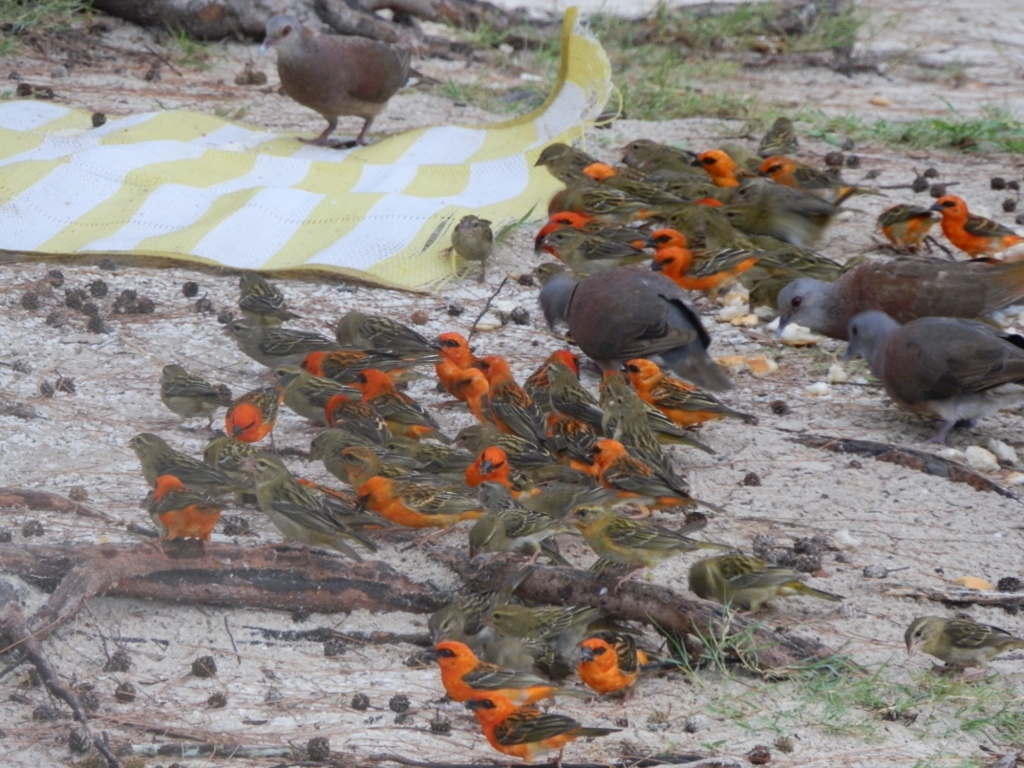 Red fody and the Malagasy turtle dove
Red fody and the Malagasy turtle dove
When reading some materials, I came across information that the Mont Choisy beach is considered to be one of the most beautiful on the island. Well, this is all relative. First, each one of us has their own taste when it comes to beaches and second, the impressions additionally depend on the weather. For instance, the beach at the Grand Baie cove was certainly not ugly by any stretch of the imagination, but we also did not find it particularly attractive. On the other hand, when I saw some photos of it made on a sunny day, I was amazed by how turquoise the water in the cove can be, while in my photo it is more of a greyish-blue hue. The same goes for the Mont Choisy beach.
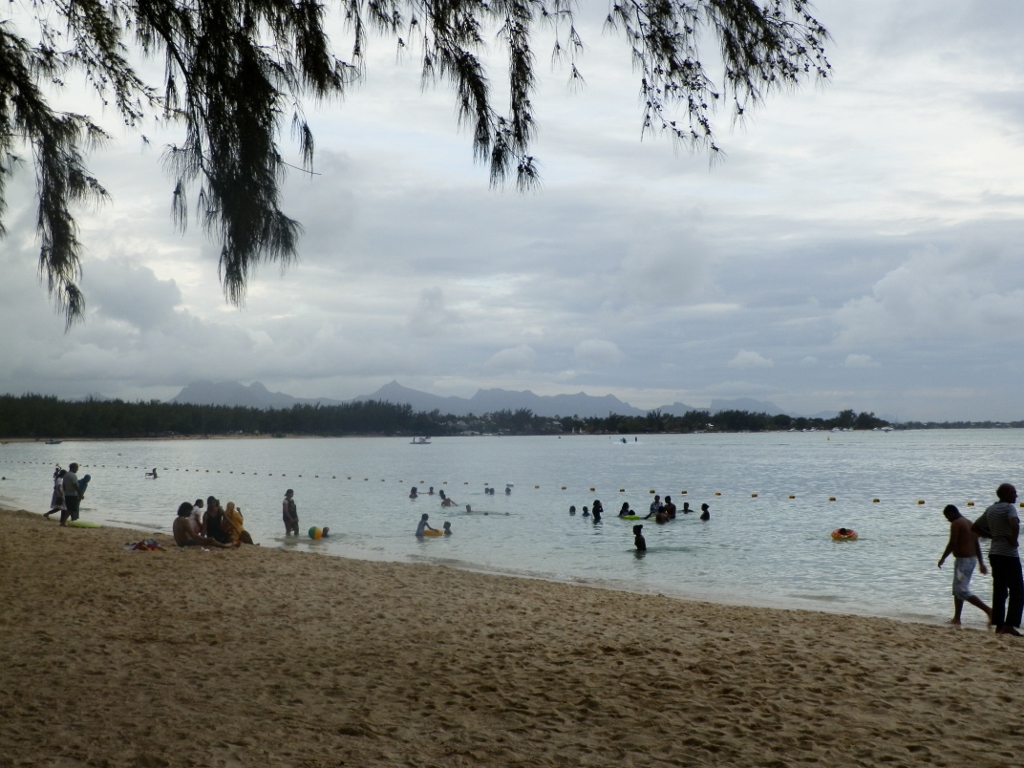 Mont Choisy beach
Mont Choisy beach
Be as it may, we preferred “our” beach. Moreover, we concluded that we got a perfect hotel and that everything in connection with it suited us: the hotel itself, the room, the food, the position (close to us there were supermarkets, fruits stands, post-office, pharmacy, ambulance, police station, although we did not need any of the last three, and – an excellent beach). Admittedly, Sneža would have preferred to have more choice when it came to evening walks, but I did not care. In fact, I did not mind going to the room and the bed right after the dinner.
But, since I’m mentioning evening outings, let me say that while we were walking around Grand Baie, Sneža and I noticed a Russian restaurant/café that had a large displayed note saying that they celebrated the Christmas Eve. Namely, it was the 6th January and since Russians and Serbs are Orthodox Christians, they share the same Christmas which is on the 7th January. Admittedly, it is by the rule a quiet holiday traditionally celebrated within the family or at the church, rather than in a restaurant. Still, when we saw this information Sneža and I decided to go there in order to mark the holiday “formally.”
The public transportation in the form of buses does not work on Mauritius when the night falls, so after the dinner we got to that restaurant/café by a taxi and later returned in the same way. But, there was no real “celebration” to speak of. Apart from us, there was also a small group of Russians there who talked amongst themselves, just like Sneža and I spoke with each other. It was pleasant, though, since we simply always have different stories to tell, but it was certainly nothing special. Still, we did not regret going there. After all, that was our main (and the only) night out during the entire stay on Mauritius.
The next day I did not get up at dawn, since I wanted to sleep more and so I woke up a little later, although it was actually still early. I made myself a coffee and was sipping it on the balcony while reading a book and then I went for breakfast. After the breakfast I came back to the room with an intention to change and go to the beach, but I was very sleepy. Whether that was because of the food, low blood pressure, deep relaxation... Who would know? And so I just spread myself over the bed. It felt great.
And then it occurred to me that there was sunshine outside and there was a beach (a tropical beach at that!) only 3-4 minutes away. And then a dilemma started: a part of me wanted to stay in bed and snooze, while a part of me wanted to go to the beach. There, everybody wants to play smart and tell you that you should follow your feelings, but what is a person to do when there are two equally strong feelings? Which one is to be followed then?
I looked at the room – it was nice and cosy and the comfortable bed was already there and I was on it. In order to go to the beach I should get up, change and walk. And then I remembered that jovial “question” of Marko, my former coach, he asked when I was telling him that I was very tired and exhausted, that I needed vacation and that this was the reason why I was going to Mauritius. After my account he said quite spontaneously: “And what? You couldn’t think of going to a local spa, but rather to Mauritius?” So, I remembered that, while lying there spread across my bed and following my feeling that wanted to keep lying there and doze. And then I thought that in order to do something like spending a long time in bed and snoozing I could have INDEED gone to some local spa. And this resolved my dilemma.
A quarter of an hour later I was on the beach. I jumped into the water right away and swam for a while and then I got back to my beach towel where I thought I might continue with my napping. It was not a bed, but there was soft sand, so it was not too bad and I thought I could have “two for the price of one.” It was not meant to be that day, or any other day for that matter, because we were sharing the beach with some tiny flies that tickled me from time to time, which I could not ignore and even less could I relax or fall asleep on the beach. Well, ok, sitting on a stunning beach on Mauritius, even if I had to chase the flies away, was far from being the end of the world.
Later I was joined by Sneža, so we stayed on the beach until early afternoon when we retired to our room since the clouds kept piling up. It rained only later in the afternoon though. It is important to say that these were all short showers, light or heavy, but certainly short. We had a room with a nice, spacious balcony that faced the hotel’s courtyard and was protected by reed shades from the floor to the ceiling that were more like reed walls, except for a larger opening through which we could look at the courtyard, so this drizzle was not too bothersome. We were on a relaxing holiday.
Already the next day we were on the move again, regardless of the weather that was nice and mostly sunny. We decided to visit a few places on Mauritius and we decided to do it on our own; I want say we did it without any local agency.
Mauritius is an island which in its longest section (along the north-south axis) has 65 km, while its biggest width (along the west-east axis) is 45 km. Its total surface area is almost 1,900 square kilometres.
Taking a public bus, we first went to Port Louis, the capital of Mauritius, not in order to visit it, but rather to change buses there and head for a place called Centre de Flacq (meaning: Centre of Flacq). The place is called like this, perhaps a little strangely at first sight, because of the fact that the region in which it is situated is called Flacq and the town is the centre of the region, which makes its name meaningful.
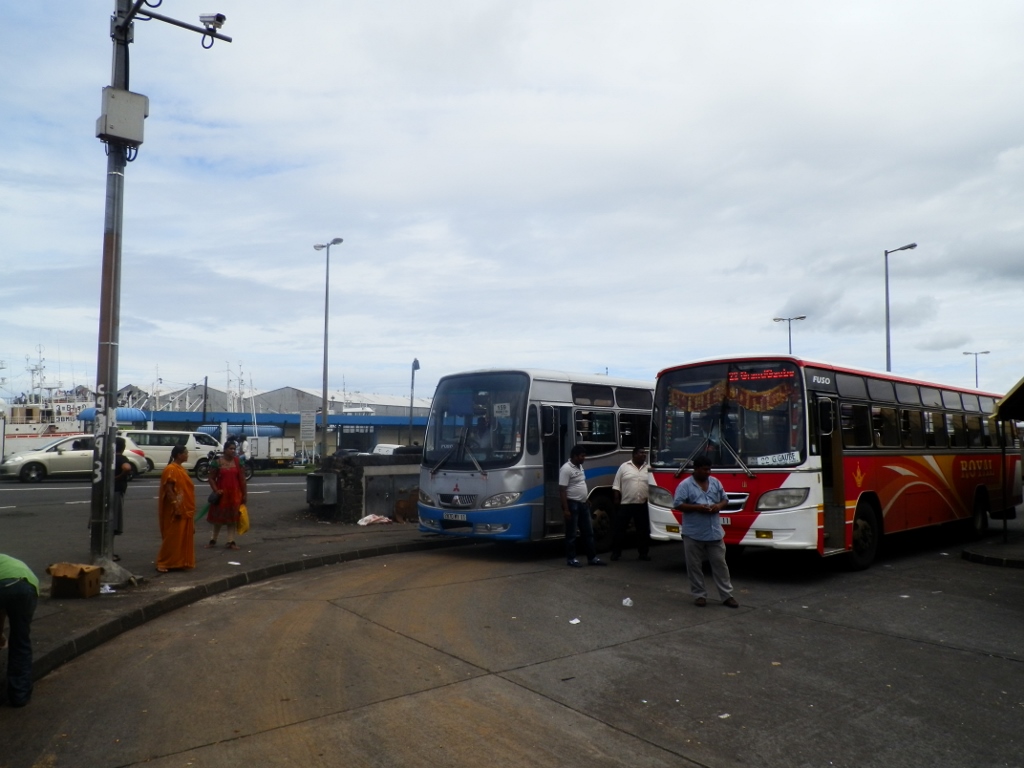 Bus terminal in Port Louis
Bus terminal in Port Louis
The reason why we went there precisely on this day was that it was Wednesday and on Wednesdays there is some big market organised in the place, so we wanted to see what it looked like.
At first we were very excited in a positive sense, since that bus ride, perhaps also because of the music which often had some Indian resonance, reminded us of India which we both love very much, but as the bus was dragging and making too many stops, which made us waste time for no particular reason (for us), the choice of the mode of transportation was getting less and less appealing. On the other hand, as the bus was going round and round, we could see the eastern parts of Mauritius. There are, for instance, a lot of fields under sugarcane.
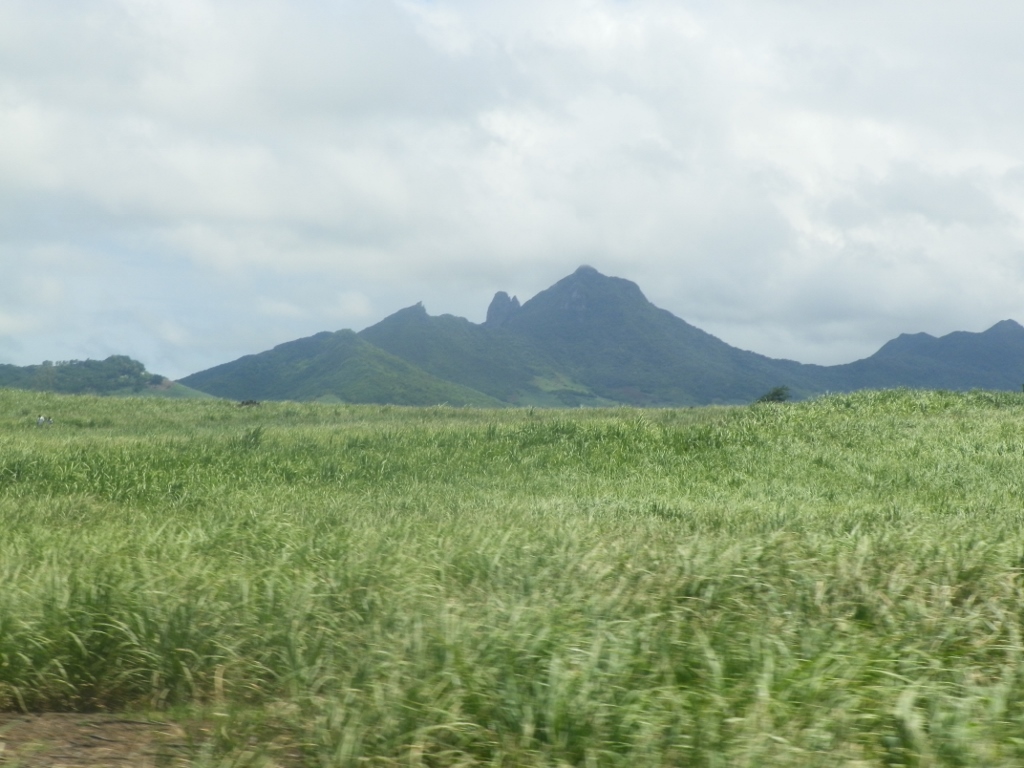 Sugarcane plantations on Mauritius
Sugarcane plantations on Mauritius
By the way, the traffic runs on the left side of the road, which is the influence of the British, but the main official language (alongside English) is French, which is the influence of the French.
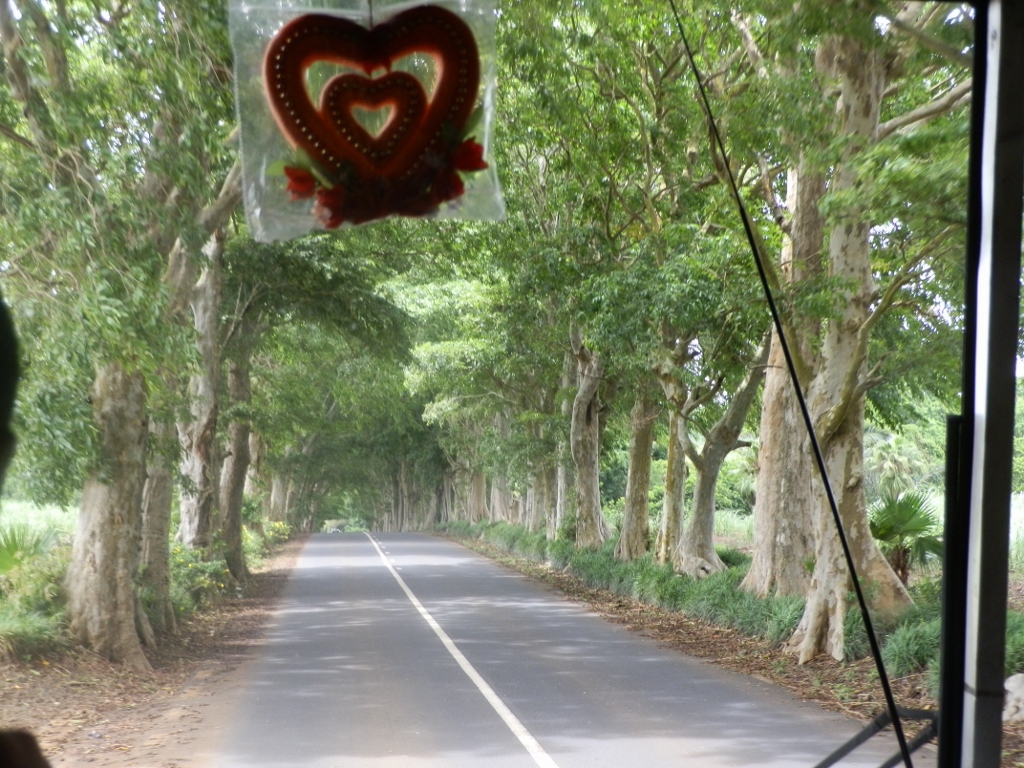 Bus ride on Mauritius
Bus ride on Mauritius
Mauritius is an almost perfect example for “Who’s who” in the field of colonial conquests (short of the Spaniards). So, this island used to be uninhabited up until the beginning of the 16th century. I mean, it was uninhabited by humans, but there was certainly life there (for instance, the famous dodo bird), for which the new “owners” of the island did not care at all. I have already written about this in the previous sequel of my travel stories from Mauritius. By the way, those new-comers also would not have cared at all even if there had been human inhabitants of the island. One just needs to see what happened in the rest of the world that was not the original territory of these colonial predators.
But, let me go back to the history of Mauritius: in 1507, the Portuguese founded a base there. In 1638 came the Dutch, who gave the present-day name to the island, and since then they started to settle here. Although from the very beginning they brought slaves from Madagascar in order for those to work on the logging of ebony, as well as on the plantations of sugarcane which the Dutch actually brought here, none of that was profitable enough and the Dutch eventually left the island in 1710.
Then came the French. In 1715 to be exact. They even changed the name of the island calling it Isle de France and it remained in their hands until 1810. As a part of the Napoleonic Wars, the French and the British fought about other territories as well, not only those in Europe and so at the end of 1810 the Brits conquered the island and they reinstated its previous name of Mauritius. Still, a part of the agreement about the takeover of the island permitted the residents to keep their property, as well as to use the French language.
And, finally, the independence of the island was proclaimed at the beginning of 1968, but the British Queen Elizabeth stayed as the head of the state. Up until 1992 when Mauritius was declared a republic (but still within the Commonwealth of Nations).
So, I have brought down this whole history to the staying on the island that used to be uninhabited and where you drive on the left side of the road passing by large sugarcane plantations, while listening to the French language on the radio.
And thus we came to the Centre of Flacq where we found the market and walked around it a little. There were different goods – seedlings, various Chinese goods, colourful pashmina shawls, as well as fruits and vegetables.
As for the fruits, we saw a lot of peeled small pineapples that had the “crest” left on them and they were sold in a small plastic bags, so that they could be turned upside-down and held like ice pops while being eaten. There were also a lot of the pitaya or the dragon fruit and I found its red version particularly interesting (I had usually seen only the white one).
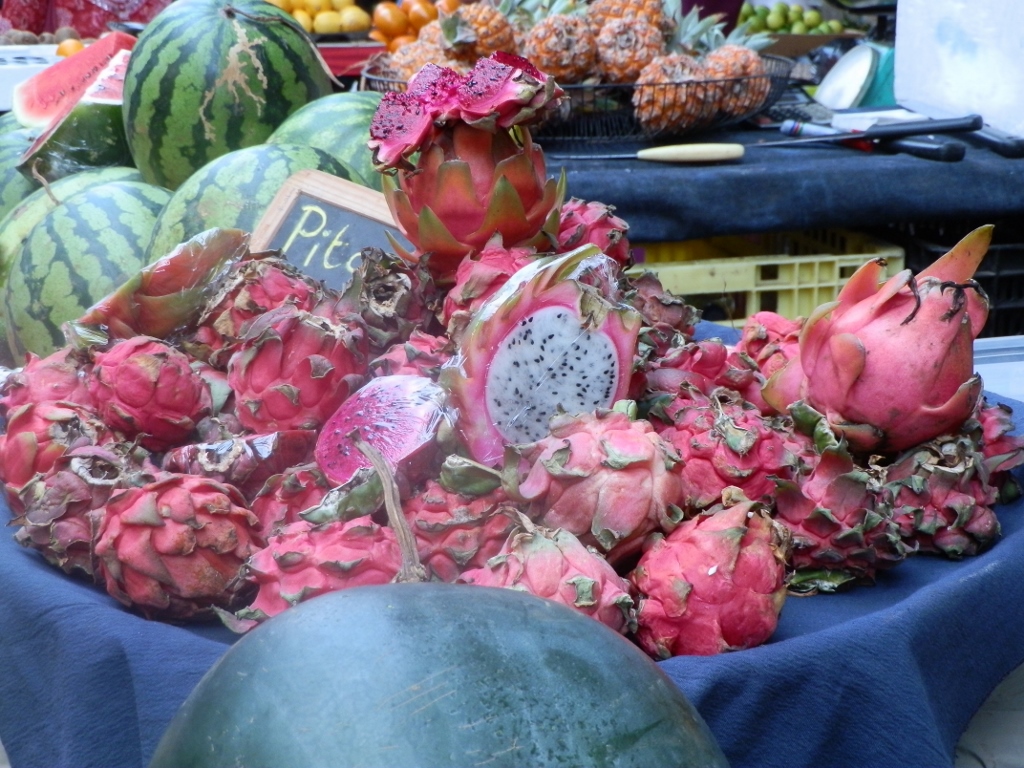 Pitaya or dragon fruit
Pitaya or dragon fruit
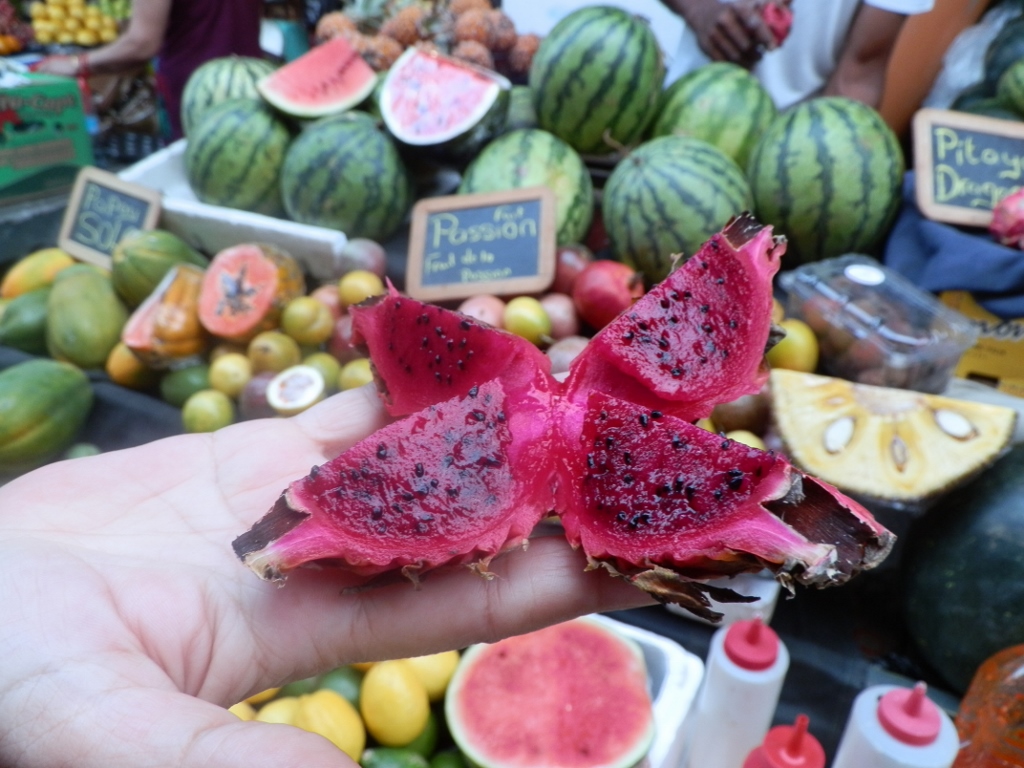 Red pitaya or dragon fruit
Red pitaya or dragon fruit
In the part with vegetables, the most interesting for us were hot peppers. Both Sneža and I like them and we take some back home from almost every journey, like a souvenir that lasts (at least for a while).
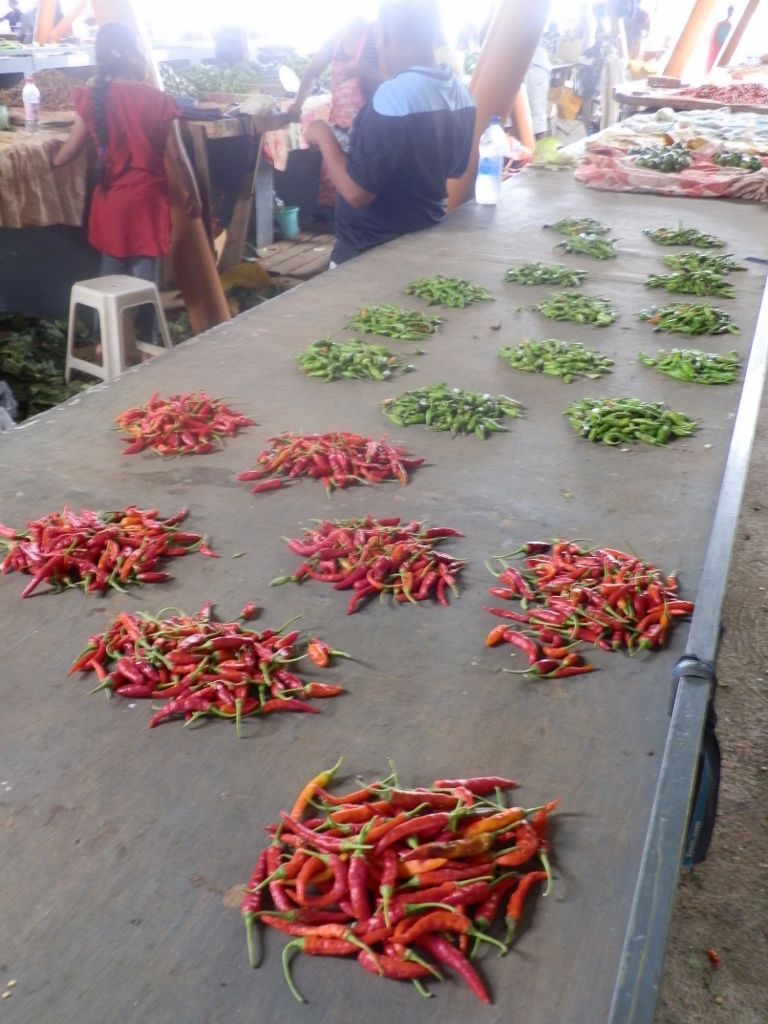 Stall with hot peppers
Stall with hot peppers
Still, we did not come to the east part of Mauritius for hot peppers. That’s why we caught another bus and transferred to a place called Trou d’Eau Douce that is situated on the very eastern coast.
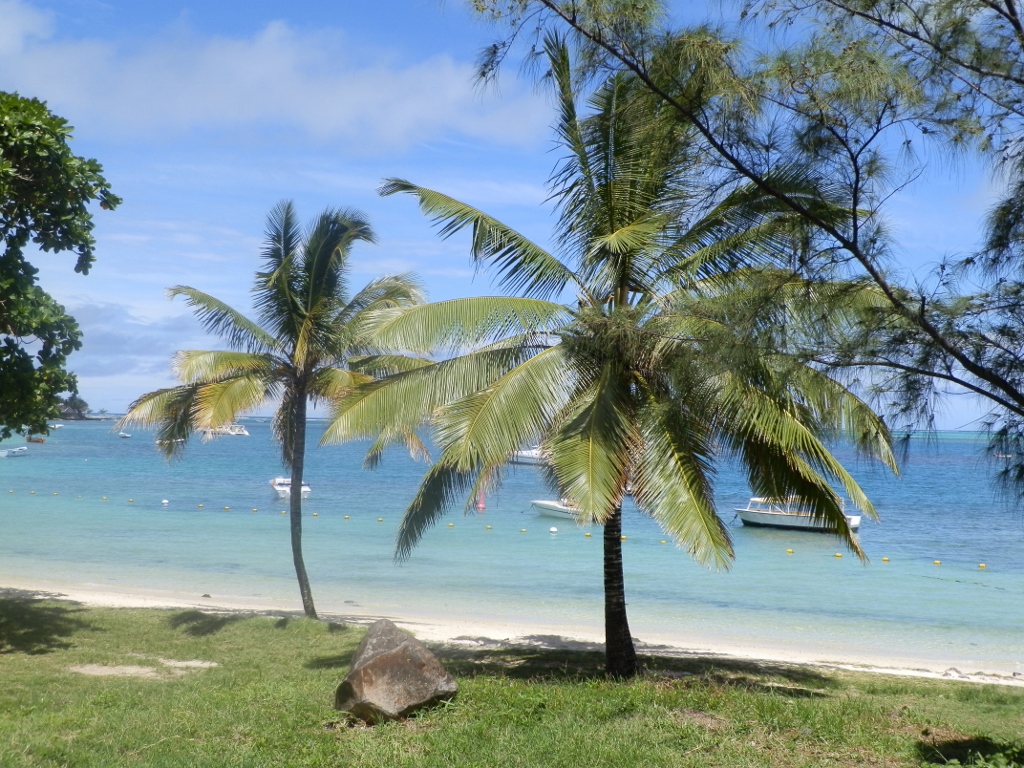 Part of the east coast of Mauritius
Part of the east coast of Mauritius
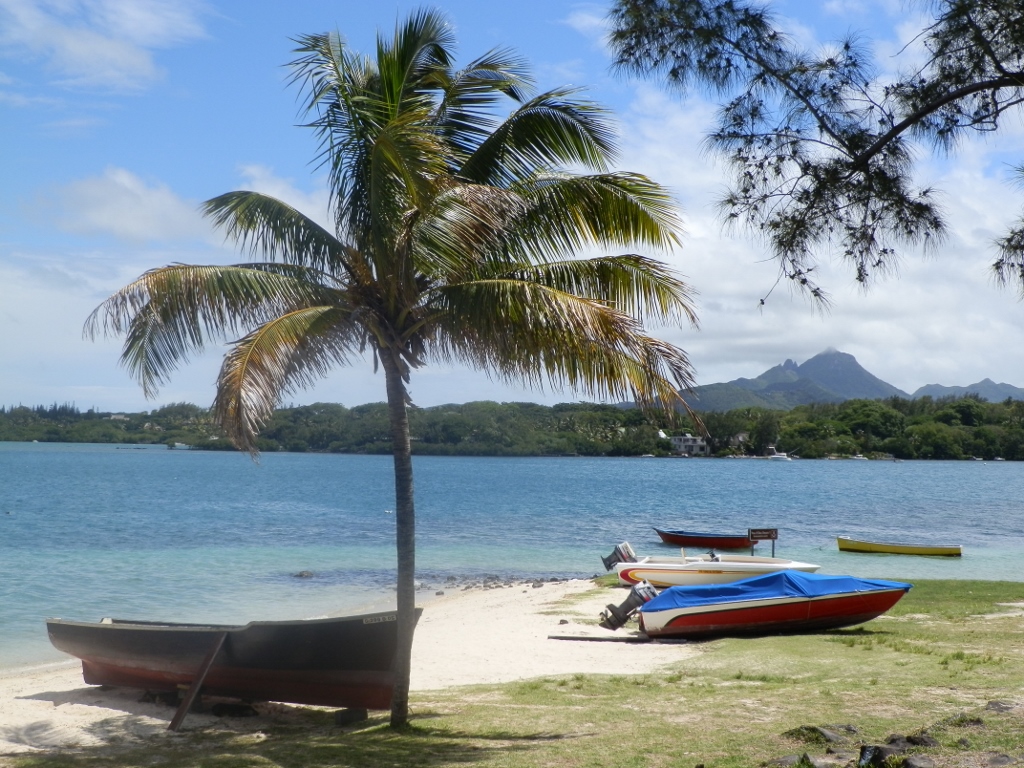 Part of the east coast of Mauritius
Part of the east coast of Mauritius
Coming to this place was important, for we were actually going to an islet close to the shore and in order to get there we had to take a boat in Trou d’Eau Douce. Our main destination for the day was Île aux Cerfs.
When we boarded the boat, we first went through a section that was the beginning of the open seas, but then the boat turned into a passage of a kind between islets (a couple of bigger ones and a number of small ones) and the mainland. There were a lot of mangroves growing there and it seemed occasionally as if we were sailing along narrow canals, while the boat went very slowly in order not to create big waves that could endanger the vegetation, as well as the underwater residents.
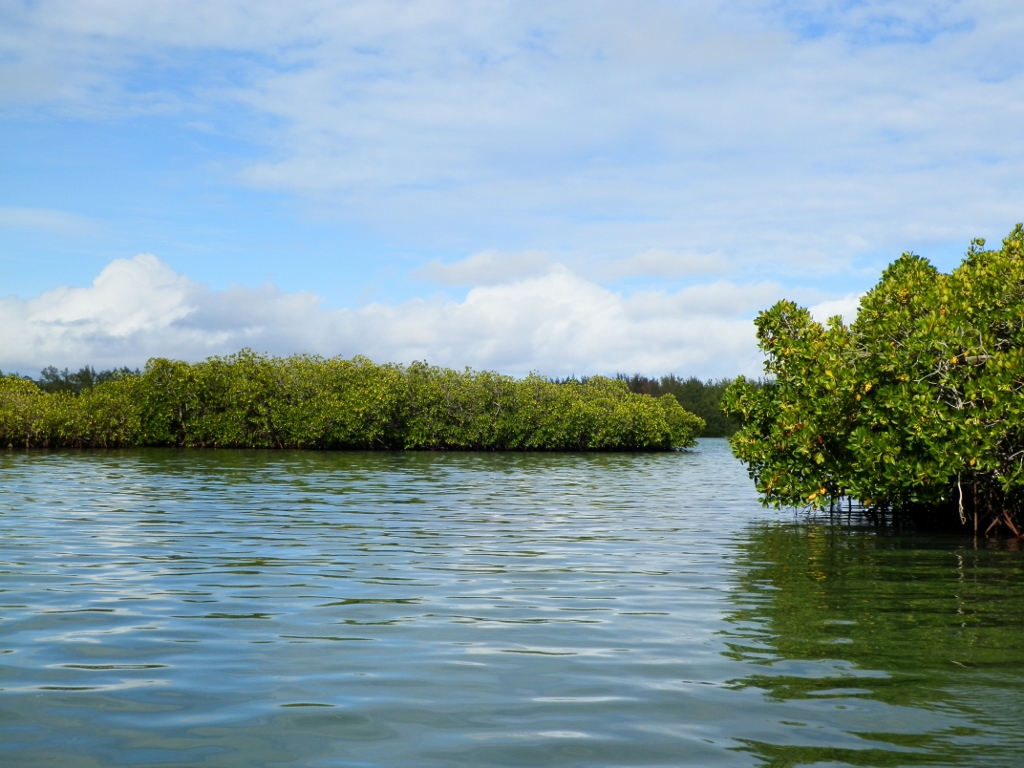 On our way to Île aux Cerfs
On our way to Île aux Cerfs
Île aux Cerfs is an islet that is located beside the east coast of Mauritius and it is in fact a private island, but its doors are open to visitors. On the islet that is not inhabited, while being earmarked for tourists, and that has 87 hectares, there are several restaurants, as well as a golf course. Tourists and local residents alike come here every day by boats from Trou d’Eau Douce because the islet is popular on account of its stunning sand beaches.
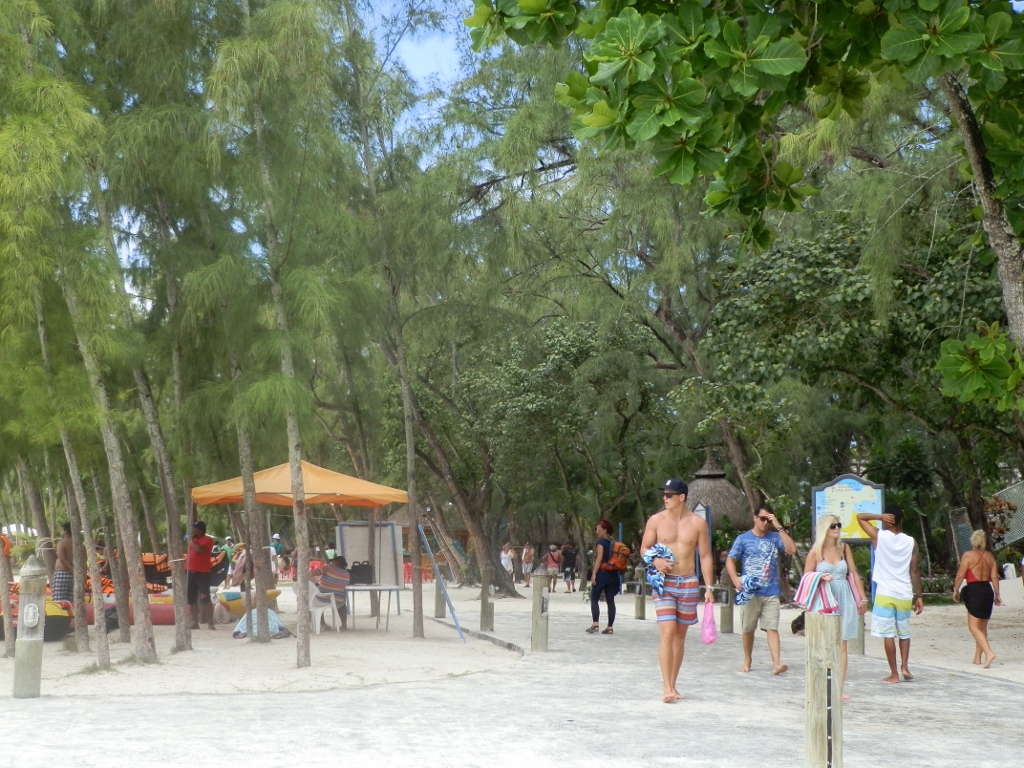 We have just disembarked on Île aux Cerfs
We have just disembarked on Île aux Cerfs
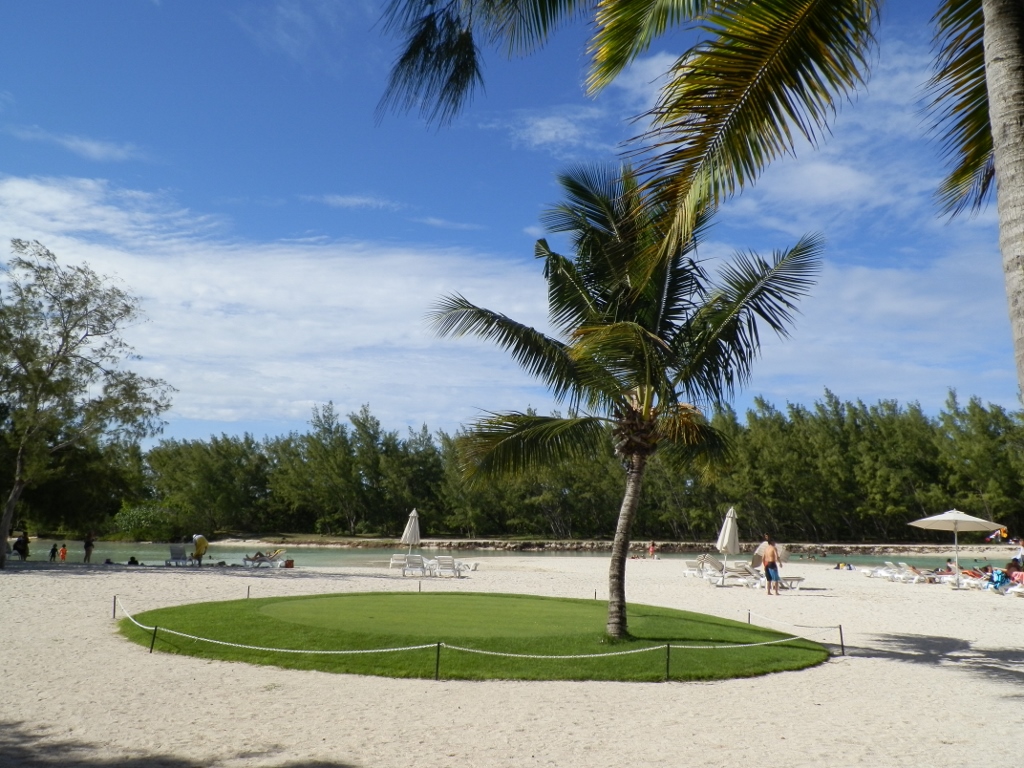 Part of a large beach closest to the boats’ dock
Part of a large beach closest to the boats’ dock
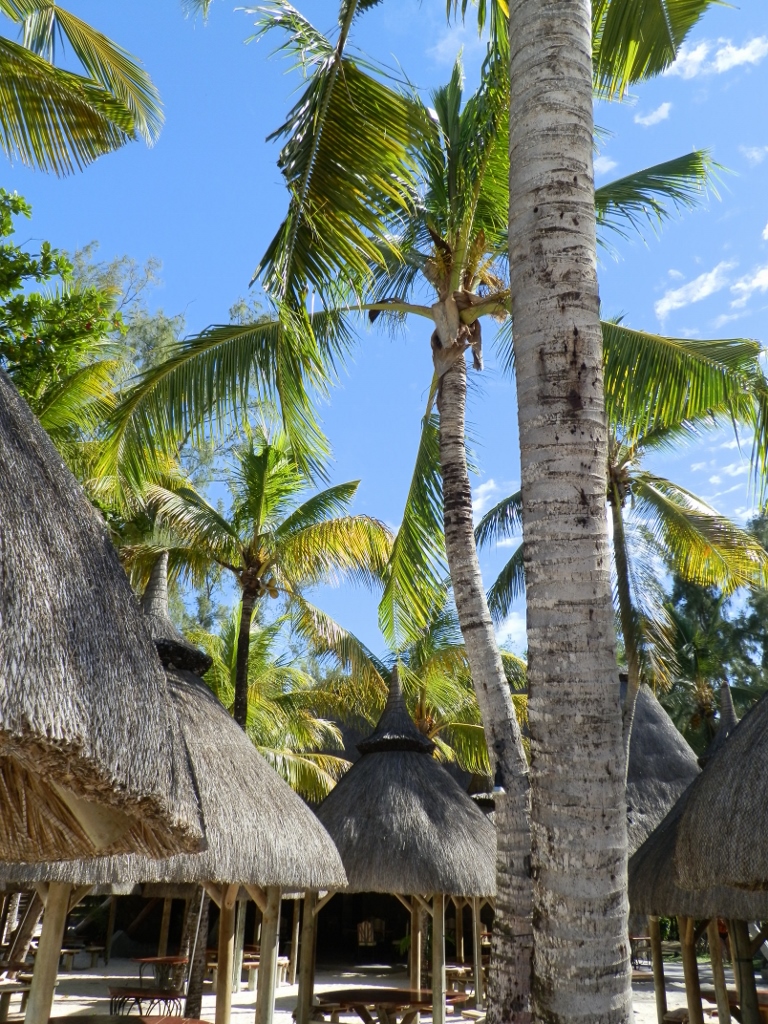 Part of the tourist infrastructure on Île aux Cerfs
Part of the tourist infrastructure on Île aux Cerfs